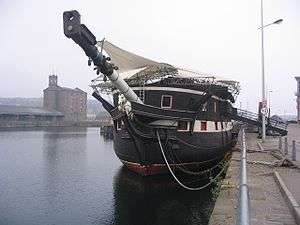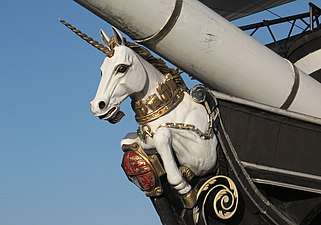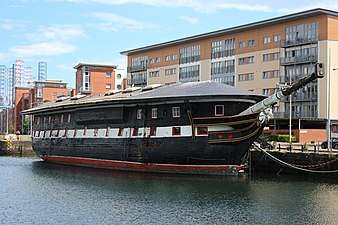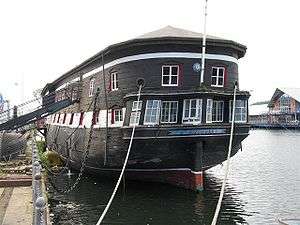HMS Unicorn (1824)
HMS Unicorn is a surviving sailing frigate of the successful Leda class, although the original design had been modified by the time that the Unicorn was built, to incorporate a circular stern and "small-timber" system of construction. Listed as part of the National Historic Fleet, Unicorn is now a museum ship in Dundee, Scotland, United Kingdom. She is one of the six oldest ships in the world, and considered to be the last intact warship from the age of sail.[1][2]
 | |
| History | |
|---|---|
| Name: | HMS Unicorn |
| Operator: | Royal Navy |
| Ordered: | 23 July 1817 |
| Builder: | Royal Dockyard, Chatham, Kent, England |
| Laid down: | February 1822 |
| Launched: | 30 March 1824 |
| In service: | 1824 |
| Out of service: | ~1964 |
| Refit: | 1824, refit during construction to receiving/barracks vessel |
| Homeport: | Dundee, Scotland |
| Status: | Museum ship, Dundee, Scotland |
| General characteristics | |
| Class and type: | Modified Leda-class frigate |
| Tons burthen: | 1077 bm |
| Length: |
|
| Beam: | 40 ft 3 in (12.27 m) |
| Depth of hold: | 12 ft 9 in (3.89 m) |
| Sail plan: | Although never given masts, she was planned as a full-rigged ship |
| Range: | Cannot move without tow (never rigged) |
| Complement: | 315 |
| Armament: |
|
History
HMS Unicorn was built in peacetime at Chatham Dockyard, Kent and launched in 1824.[3] This was a transitional period for shipbuilding, as suitable timber was becoming more difficult to obtain, and iron was increasingly available. Under the direction of Sir Robert Seppings, then Surveyor of the Royal Navy, Unicorn was built with diagonal riders made with iron straps and iron "knees" that strengthened the hull.[4]
As Unicorn was built shortly after the naval wars against Napoleon ended, she was never rigged; she only went to sea for the voyage from Chatham to Dundee, during which she was under tow. A superstructure was built over her main deck and she was laid up "in ordinary", serving as a hulk and a depot ship for most of the next 140 years. Her lack of active duty left her timbers well preserved, and in the 1960s steps were initiated to convert her to a museum ship. The roof that covers her upper deck is thought to be original, although portions of it were removed in the 1970s, leading conservators to replace the foc'sle roof.[5][6][7]
Though steps were taken to restore Unicorn[n 1] to a similar condition as her sister ship HMS Trincomalee, this plan has been changed. The ship was found to be the only example of a wooden frigate of her type existing in ordinary, and as a result, the intention is now to preserve her in her current condition.
In April 2019, the Unicorn Preservation Society received a National Lottery Resilient Heritage Fund Grant in the amount of £28,900.[1]
Princess Anne is patron of the Unicorn Preservation Society.[8]
 Unicorn at the bowsprit
Unicorn at the bowsprit Side view
Side view Stern view
Stern view
Notes
- Including the addition of the totally new bowsprit visible in the picture.
References
- "Historic HMS Unicorn gets £29k lottery cash ahead of 200th anniversary". Evening Telegraph. ISSN 0307-1235. Retrieved 22 April 2019.
- Breverton, Terry, 1946- (2010). Breverton's nautical curiosities : a book of the sea. New York: Quercus. ISBN 9781623653200. OCLC 869301594.CS1 maint: multiple names: authors list (link)
- "The History of HMS Unicorn". HMS Unicorn. Retrieved 22 April 2019.
- "Sir Robert Seppings". HMS Unicorn. Retrieved 22 April 2019.
- "HMS Unicorn: Summary from the Official HMS Unicorn website". Archived from the original on 15 June 2010. Retrieved 15 June 2010.
- "Dundee's historic Frigate Unicorn could be enclosed in new building". Evening Telegraph. ISSN 0307-1235. Retrieved 22 April 2019.
- "Recent Conservation". HMS Unicorn. Retrieved 22 April 2019.
- "Princess Royal steps on board Dundee's Frigate Unicorn". Dundee Courier. Archived from the original on 5 October 2012.
Footnotes
- David Lyon and Rif Winfield (2004), The Sail and Steam Navy List: All the Ships of the Royal Navy 1815-1889. Chatham Publishing. ISBN 1-86176-032-9.